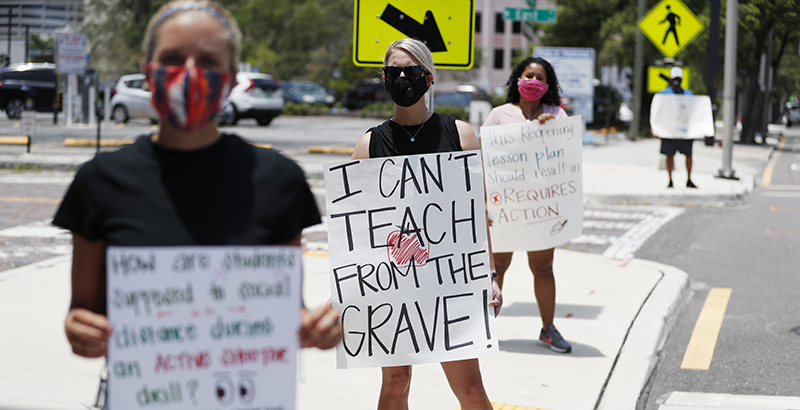Analysis: Teachers Unions Are Positioning to Negotiate How and When Schools Will Reopen. Money, Not Safety, Will Decide

Mike Antonucci’s Union Report appears most Wednesdays; see the full archive.
We have spent months arguing about whether schools should reopen for in-person instruction, when, where, how, why and how much. It’s a frustrating conundrum because individual school employees, students and parents have their own levels of risk tolerance, but their decisions can’t be made in isolation. One person’s actions can affect the health and safety of others — kind of like bringing your peanut butter and jelly sandwich to school when you have 20 classmates with peanut allergies.
There is no magic number below which schools will be “safe.” If districts and politicians are rational, they will make reopening decisions based on trends. More vaccinated people, more personal protective equipment and more testing will help, as will lower infection rates, lower mortality and less crowded hospitals.
But at some point you have to open the schoolhouse doors, and since any point chosen will be mostly arbitrary, that point will have to be, well, arbitrated. That means negotiating, in some form, among stakeholders — which in the case of public schools and the overall economy is just about everybody.
The teachers unions recognized this well before anyone else. They know a bargaining situation when they see one. That’s why for the past 10 months various local and state unions have issued reopening requirements, while the national unions released guidelines and funding demands. As is usually the case, some demands are reasonable, others are not, and still others are bargaining chips to be discarded in exchange for something the unions actually want.
No one will argue against the kinds of safety measures that have been instituted in other indoor spaces, and certainly all school employees should be masked, tested and vaccinated to the fullest extent possible.
Other measures, such as shortening the school day or rotating schedules, will be more difficult to negotiate but are surmountable problems.
The sticking points will be staffing levels, sick leave, class sizes and COVID-related absences and accommodations. No one should be surprised that unions are floating a bunch of wish list items as well.
Randi Weingarten, president of the American Federation of Teachers, wants “food programs, guidance counselors and health and mental health services,” along with “community schools, smaller classes, tutors coordinating with teachers, extra learning time, enriched afterschool and summer school, social and emotional learning and culturally responsive practices.” And no standardized tests.
The National Education Association wants at least $175 billion in additional federal dollars “to stabilize education funding … based on projected revenue losses in FY2020 and FY2021.” The union constructed a table showing projected funding losses for each state.
I can’t speak to what’s going on in 49 states, but NEA projected a three-year, $83.4 billion loss for California. It looks to be a little off. The California state government took in record revenues in 2020 and has $34 billion more than it needs to balance the budget.
Both national unions are advocating for school employees to be placed at the front of the line for vaccines but did not offer assurances that this would result in a return to in-person instruction. The California Teachers Association specifically noted that schools located in areas with elevated infection rates should remain closed even if employees are vaccinated.
Whether this will fly with the public is an open question, but there is little to be done if teachers refuse to return to work, justified or not. There is only one effective tool against teacher strikes: withholding pay. It will be a rare school district or state government with the stomach for that kind of fight.
So it will take cash to purchase union buy-in to any reopening plan. The form it takes will vary from place to place, but it will certainly require additional hiring. Whether teachers will actually be safer after a deal is struck is debatable, but their risk assessment will change if it comes with the potential loss of a paycheck.
Get stories like these delivered straight to your inbox. Sign up for The 74 Newsletter

;)